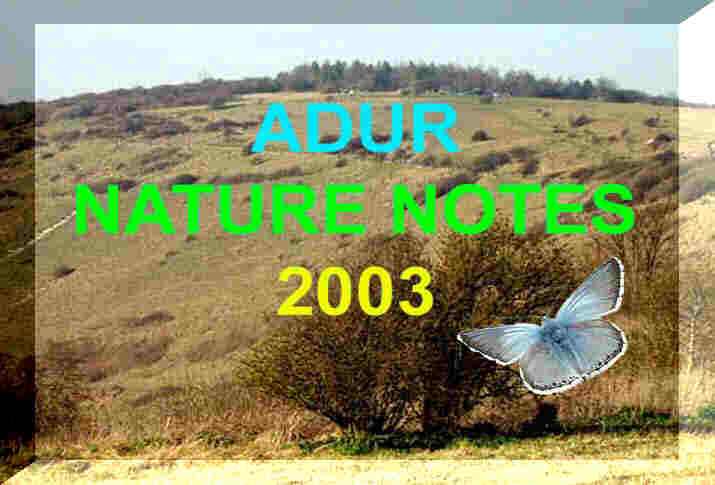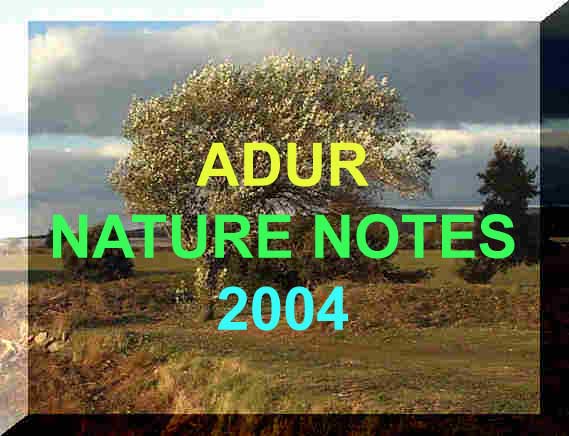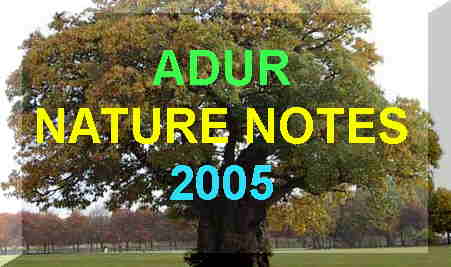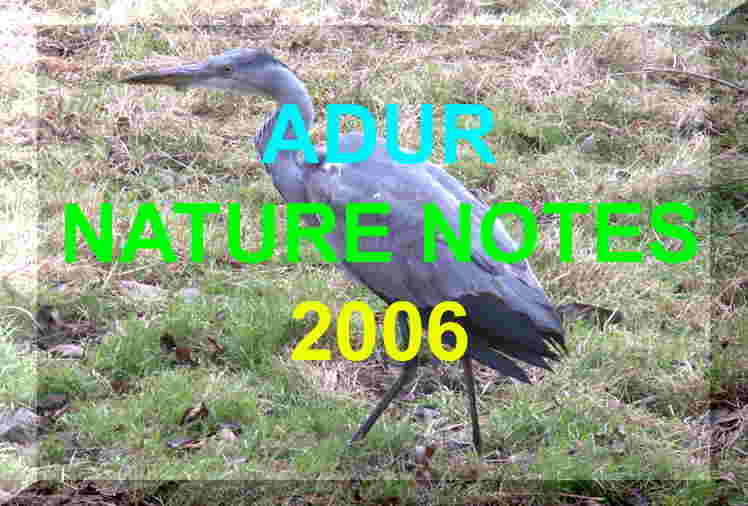including the Adur Levels, Mill Hill and cyclepath to Upper Beeding
Link to Adur Fungi 2007
 17
December 2006
17
December 2006
I
noted the following mushrooms in passing: frequent Panaeolus
papilionaceus var papilionaceus
and
at least one Snowy Ink Cap, Coprinus
niveus on horse droppings piled up
on the edge of a field by the Steyning Road, Old Shoreham; occasional Wood
Blewit, Lepista nuda,
mushrooms
and the small Candle Snuff Fungus, Xylaria
sp.,
in
the Field Maple Spinney between the Steyning
Road and the Waterworks Road;
and one discarded probable White Dapperling,
Leucoagaricus
leucothites on the ridge of Mill Hill.
13
December 2006
The
Wood
Blewit, Lepista nuda,
mushrooms
were now only occasionally seen in the Field
Maple Spinney between the Steyning Road and the Waterworks
Road. All of them were now brownish.
| The
small Candle Snuff Fungus, Xylaria
sp.,
was
also present in small amounts on wooden tree stumps.
A small clump of the Glistening Inkcap, Coprinus micaceus, were spotted on the muddy path between the Waterworks Road and the Butterfly Copse below Frampton's Field. These inkcaps had not been seen here before. |
 |
 |
| 6
December 2006
Wood Blewit, Lepista nuda, mushrooms grow on the leaf litter and not in the soil as written in some of the books. These mushrooms were still frequently seen in the Field Maple Spinney between the Steyning Road and the Waterworks Road. The older mushrooms had lost their bluish tinge and were beginning to turn brownish. |
 |
 |
I discovered some unusual blue-green mushrooms in a shady lawn area of St Bernards Court, Broadwater, Worthing. They were close to some wooden edging.
and on the flickr British Fungi & Lichens Gallery
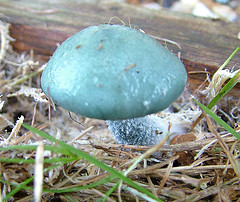 |
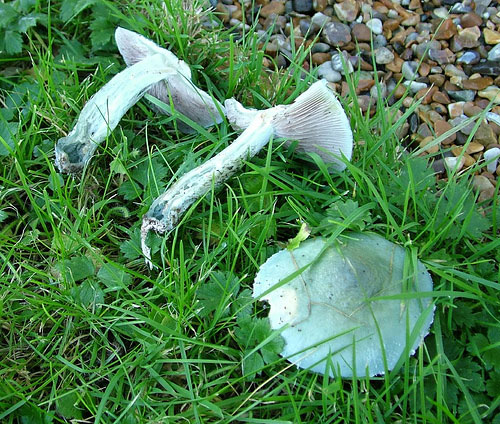 |
 |
These were first identified (incorrectly) as fresh specimens of the Verdigris Agaric, Stropharia aeruginosa, the first of this species recorded on these Nature Notes pages.
I wondered
about Stropharia aeruginosa,
as the cap is much brighter blue than you normally see in Stropharia
caerulea or Stropharia
pseudocynea.
But Stropharia aeruginosa
is an uncommon woodland species and your habitat looked like amenity grassland
(there was a board and a straight edge to the grass) which is dead right
for Strophari acaerulea.
Stropharia
aeruginosa
has a persistent, spreading, membranous ring, whereas the other two have
a weak fugacious (=disappearing) ring. It also has white spots on the cap
margin, although these can wash off. If you want to be really certain,
you need to check the cystidia on the gill edge (microscope).
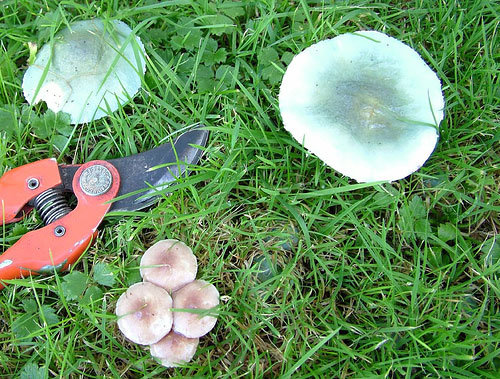 |
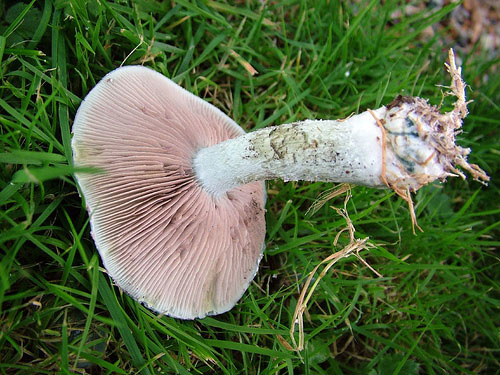 |
Further photographs by Ray Hamblett were taken that seems to lead to my original ID.
The
consensus on the
important Fungi
of the British Isles (Yahoo Group) was that these
were a species of Stropharia.
Another
Image (Link)
27
November 2006
The
number of Wood Blewit, Lepista nuda,
mushrooms
on the leaf litter in the Maple Spinney between
the Steyning Road and the Waterworks Road
was now over 25 and the largest ones measured over 70 mm in diameter. There
was one closed Common Ink Cap,
Coprinus
atramentarius next to a buried root or
twig.
 |
23
November 2006
In Lancing Clump the Golden Pholiotas were past their best. They were underneath their usual Ash tree. |
| 21
November 2006
A handful of Wood Blewit, Lepista nuda, mushrooms protruded from the leaf litter (to which they were attached as decomposers) in the Maple Spinney between the Steyning Road and the Waterworks Road. The
small Candle Snuff Fungus, Xylaria
sp.,
was
also present in small amounts on wooden tree stumps.
|
 |
 |
1
November 2006
One problematic mushroom was recorded amongst the Horseshoe Vetch next to a Rabbit latrine on the lower slopes of Mill Hill. Report with Images |
30
October 2006
 |
 |
 |
The two small mushrooms above appeared attached to the leaf litter in the Maple Spinney between the Steyning Road and the Waterworks Road. The first white specimen (its gills were white) was associated (if not growing on?) with a partially buried wood or root, but the second blue specimen had already been dislodged from its leaf litter and was lying prone when discovered. The first was thought to be a young Common Ink Cap, Coprinus atramentarius, and the second a young Wood Blewit, Lepista nuda.
28
October 2006
Four
species of mushroom have now been seen in a field by the Steyning Road,
Old Shoreham.
Snowy Ink Cap, Coprinus
niveus, was now recognised and the
snowy/flaky appearance of the conical cap could be seen clearly. One older
mushroom had a flat cap.
 |
 |
 |
 |
The second mushroom was frequently seen in the grass next to the dung and looked very similar in shape, but the cap and stem were dark and the caps were slightly larger. My first identification is for Panaeolus rickenii (wrong, see below). I could not get a closer look at the mushrooms because of the barbed wire and electric fence. A third mushroom was also seen in the dung. I think this latter one was a species of Conocybe. The fourth species has a flattened cap and was much larger, estimated at over 60 mm cap diameter with a stem that could not be seen.
Image
2 (above):
Panaeolus
papilionaceus var
papilionaceus.
You
were close! P.rickenii (now called P.
acuminatus) is more purple brown.
Bioimages
image link for this species
27
October 2006
Mushrooms
discovered in the afternoon were a dozen the white-capped species growing
on horse droppings piled up on the edge of a field by the Steyning Road,
Old Shoreham.
These are illustrated in the
first two photographs on the left below. The
white stems of this species were hollow.
Species:
Snowy
Ink Cap, Coprinus
niveus
Adur
Dung Fungi
 |
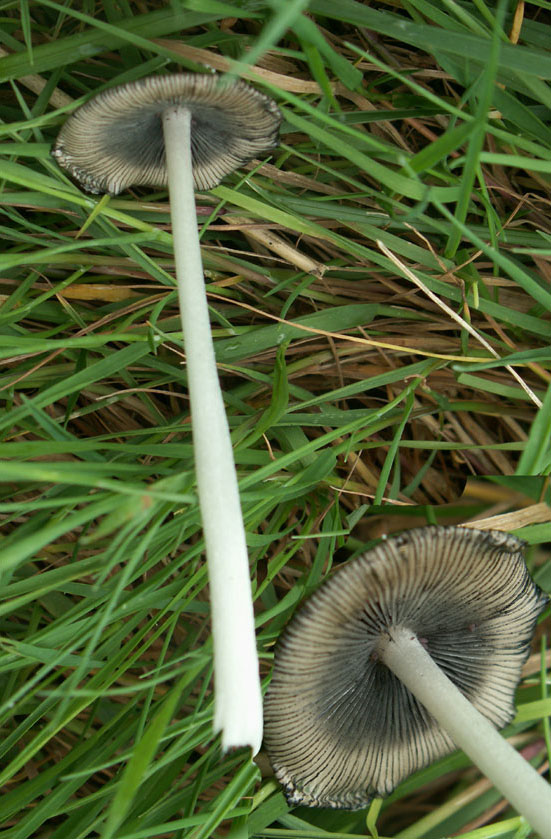 |
 |
 |
The small Candle Snuff Fungus, Xylaria sp. was seen in the Maple Spinney between the Steyning Road and the Waterworks Road with the remains of a large badly damaged Sulphur Tuft, Hypholoma sublateritium, (possibly a Wood Blewit). There were Jew's Ears on a Hawthorn on the scrub on the lower ridge of Mill Hill. And I spotted what were half a dozen probable Lactarius pubescens (a type of Milk-Cap)* on the verges of Mill Hill Road where the Bee Orchids were discovered earlier this year. They were on grass and herbland about one metre from two Silver Birch trees. (Photograph above, far right.) (I originally penned these as Sulphur Tufts.)
23
October 2006
Amongst
a patch of long grass near (west of) the Reservoir on Mill
Hill and surrounded by Hawthorn
bushes, the tall mushroom Volvariella
gloiocephala was spotted to the side
of me as I walked along the path. It is illustrated
(first left) below.
 |
 |
 |
 |
After
the rain, a couple of mushrooms
and the Nostuc
commune
was there as expected on the lower
slopes of Mill Hill.
Again
the mushrooms
(illustrated
in the centre two frames above) were elusive
to identify. The gills were greyish-white but similar mushrooms have been
seen with black gills on the upper part of Mill Hill before. There was
no sign of a ring around the stem. The cap was about the size of a commercial
mushroom, an estimated 55 mm in diameter.
Entoloma
bloxamii.
BioImages
image link for this species
The
final small mushroom
on the far right (above) was seen on a small mossy wood stump in
the Maple Spinney between the Steyning Road and the Waterworks
Road.
 |
20
October 2006
Mushrooms appeared amongst the leaf litter at the base of a tree in the Maple Spinney between the Steyning Road and the Waterworks Road. They were already in a deteriorated condition and they looked like one of the Ink Caps, Coprinus. |
12
October 2006
 |
 |
On
the lower slopes of Mill
Hill, One medium-to-large white mushroom seen at the southern end had
a pure white cap with a diameter of 55 mm, white gills and a white 90 mm
stem with a ring, and it was probably the White
Dapperling, Leucoagaricus
leucothites. Two more were seen in
the central area of Mill Hill.
Fungi
of Mill Hill
8 October
2006
On
the lower slopes of Mill Hill, a handful
of small mushrooms protruded above the short grass and herbs. This
fungus has now been identifed as a species of Stropharia.
There was another larger mushroom just above the ridge, but this had black
gills and appears to be an Agaricus species. These were species
seen frequently before and every year at varying times, usually after rain.
Images
4 October
2006
Two
Shaggy
Parasol,
Macrolepiota
rhacodes mushrooms were seen in the pile of leaves next to the
twitten
between Corbyn Crescent and Adelaide Square, Shoreham, on the edge of the
Middle Road allotments. These mushrooms are found here every year, at least
for the last three years.
6 September
2006
Honey
Fungus was seen on Hawthorn on Mill
Hill (on the northern part of the lower
slopes by the path that enbters the scrub).
| 28
May 2006
A mushroom with a cap diameter of 28 mm and a height of about 35 mm grew amongst the herbs of the lower slopes of Mill Hill. There was a smaller specimen on the short sward upper plateau as well. This mushroom has been seen before. This
is probably Stropharia. The exact species could be one of
two.
|
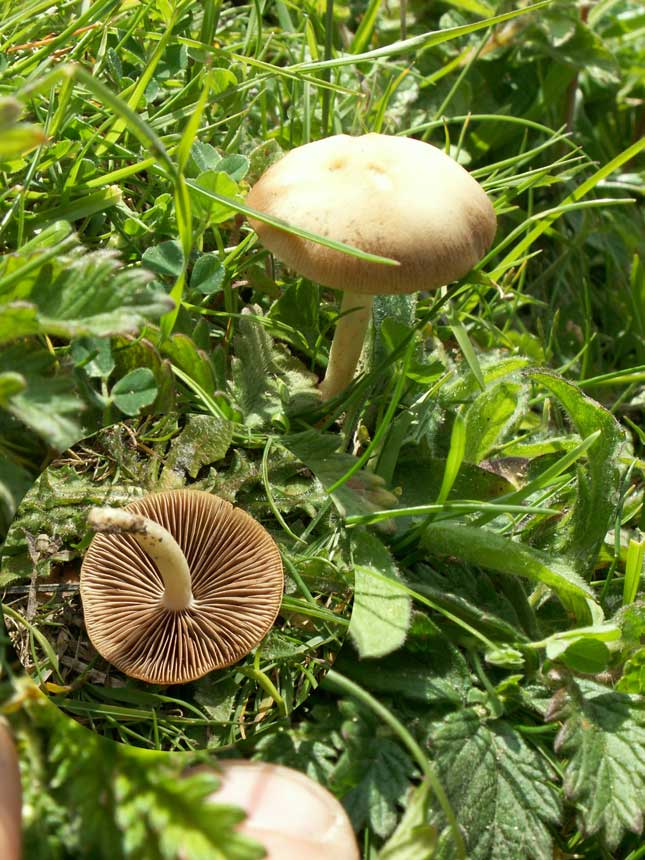 |
10
& 21 May 2006
A
single mushroom appreared (two mushrooms on separate dates) amongst the
grass in my front garden of the rather dull
species Coprinus
plicatilis.
 |
 |
 |
The small mushroom above was frequent (12+) on Spring Dyke, north of Old Shoreham. The largest specimen (illustrated on the far right above) had a cap diameter estimated at 25 mm, but most of them were half this size.
24
April 2006
It
was hazy misty it the late afternoon. The small mushroom was discovered
again on the lower slopes of Mill
Hill.
 |
 |
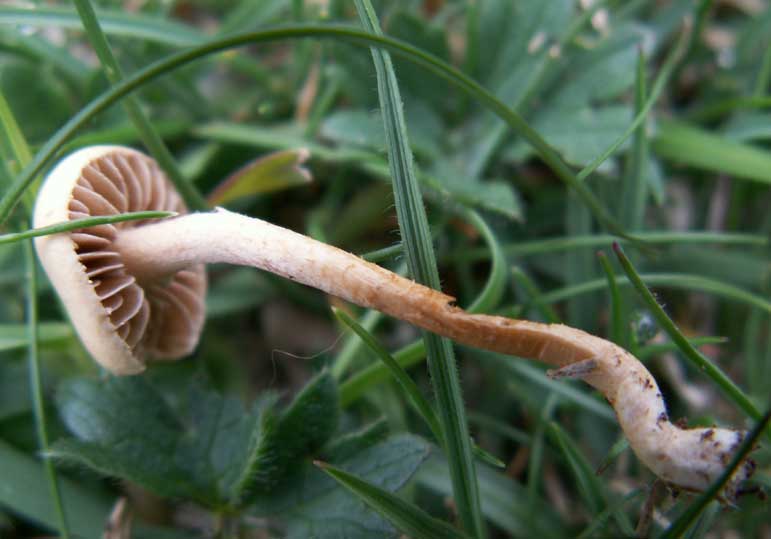 |
I
have still not identified this species which is an irregular occurrence
after rain. This is probably Stropharia sp. This might be
a different species at S. semiglobata.
| 23
April 2006
It rained steadily but lightly for almost the complete day up until about 5:00 pm. This have led to the appearance of the mushroom illustrated on the right growing out of the still extensive (complete covering) leaf litter in the Maple Spinney between the Steyning Road and the Waterworks Road. Notice the purplish tinge on the gills and stem. I think this is the common species, probably Hypholoma sublateritium. |
 |
 |
| 21
April 2006
There was a surprise clump of mushrooms next to the Slonk Hill Cutting path on the south side. Could these be Sulphur Tufts? |
 |
 |
There was a surprise clump of mushrooms next to the Slonk Hill Cutting path on the south side.
 16
February 2006
16
February 2006
The
fungi on a felled fallen Ash on Lancing
Clump looked very much like the Tripe
Fungus, Auricularia
mesentrica.
1
February 2006
A
single small (5 pence-sized) mushroom on the flattened reeds of the Spring
Dyke was a Tubaria
furfuracea.
 |
 |
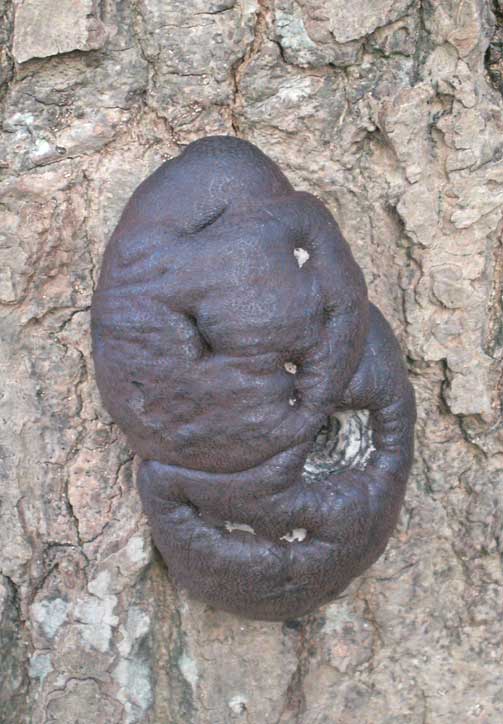 I
did not discover this small insect (springtail?)
until I examined the photograph.
I
did not discover this small insect (springtail?)
until I examined the photograph.
20
January 2006
Fungi
noted in the wood to the east of McIntyres Field (east of Lancing
Clump) were the black blobs called
King
Arthur's Cakes, Daldinia concentrica, on
upright and fallen trees and there were many fallen trunks and branches
in the wood and under Lancing Clump where I recorded some Trametes
bracket
fungi.
9 January
2006
On
the rotten Elm
north of Ladydell's, north of Cuckoo's
Corner on the Coombes Road, there were orange fungi growing on the
dying trees. These were Velvet Shank
and there was at least one Jew's Ear. There
was also a small clump of Honey Fungus.
| 5
January 2006
My first fungus recorded this year was a small clump of Honey Fungus on a living tree next to the Waterworks Road, followed by several Jew's Ear,Auricularia auricula-judae, on a prone and rotten branch. Photographs: Jew's Ear, Auricularia auricula-judae |
 |
 |
